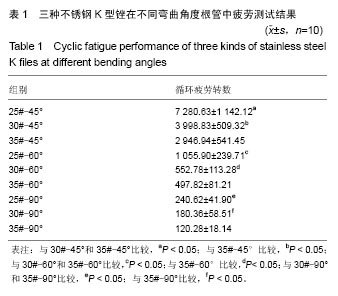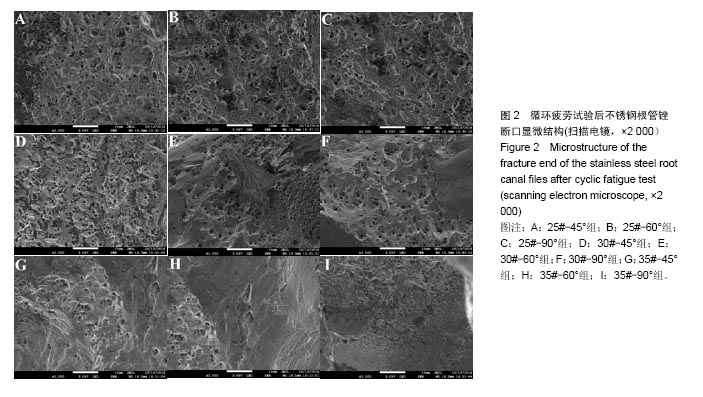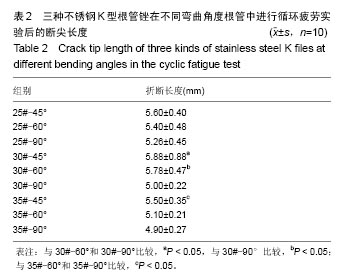| [1]钱海虹.根管治疗中器械折断原因分析及防范措施[J].现代口腔医学杂志,2015,29(2):114-119.
[2]Kaval ME, Capar ID, Ertas H. Evaluation of the Cyclic Fatigue and Torsional Resistance of Novel Nickel-Titanium Rotary Files with Various Alloy Properties. J Endod. 2016;42(12): 1840-1843.
[3]Jamleh A, Adorno CG, Ebihara A, et al. Effect of nickel titanium file design on the root surface strain and apical microcracks. Aust Endod J. 2016;42(1):25-31.
[4]Elnaghy AM. Cyclic fatigue resistance of ProTaper Next nickel-titanium rotary files. Int Endod J. 2014;47(11): 1034-1039.
[5]Shen Y, Riyahi AM, Campbell L, et al. Effect of a combination of torsional and cyclic fatigue preloading on the fracture behavior of K3 and K3XF instruments. J Endod. 2015;41(4): 526-530.
[6]Scattina A, Alovisi M, Paolino DS, et al. Prediction of Cyclic Fatigue Life of Nickel-Titanium Rotary Files by Virtual Modeling and Finite Elements Analysis. J Endod. 2015; 41(11):1867-1870.
[7]Lee SW, Park YG. Cyclic fatigue resistance of ProTaper Next nickel-titanium rotary files. Int Endod J. 2015;48(11):1100.
[8]Nisha G, Amit G. Textbook of endodontics. JP Medical Publishers, 2007.
[9]仇宁.镍钛根管预备器械研究进展[J].中国实用口腔科杂志, 2015,8(5):313-316.
[10]Miyara K, Yahata Y, Hayashi Y, et al. The influence of heat treatment on the mechanical properties of Ni-Ti file materials. Dent Mater J. 2014;33(1):27-31.
[11]Elnaghy AM. Cyclic fatigue resistance of ProTaper Next nickel-titanium rotary files. Int Endod J. 2014;47(11):1034-1039.
[12]顾永春,倪龙兴. 2061支临床废弃手用ProTaper锉的损伤分析[J]. 上海口腔医学,2013,22(5):528-532.
[13]韦宁. 机用镍钛锉预备根管的效果观察[J]. 现代实用医学, 2013,25(3): 305-307.
[14]Dagna A. Nickel-Titanium Single-file System in Endodontics. J Contemp Dent Pract. 2015;16(10):834-839.
[15]Yürüker S, Görduysus M, Küçükkaya S, et al. Efficacy of Combined Use of Different Nickel-Titanium Files on Removing Root Canal Filling Materials. J Endod. 2016;42(3): 487-492.
[16]Duke F, Shen Y, Zhou H, et al. Cyclic Fatigue of ProFile Vortex and Vortex Blue Nickel-Titanium Files in Single and Double Curvatures. J Endod. 2015;41(10):1686-1690.
[17]Aminsobhani M, Meraji N, Sadri E. Comparison of Cyclic Fatigue Resistance of Five Nickel Titanium Rotary File Systems with Different Manufacturing Techniques. J Dent (Tehran). 2015;12(9):636-646.
[18]Agrawal V, Kapoor S, Patel M. Ultrasonic Technique to Retrieve a Rotary Nickel-Titanium File Broken Beyond the Apex and a Stainless Steel File from the Root Canal of a Mandibular Molar: A Case Report. J Dent (Tehran). 2015; 12(7):532-536.
[19]Ha JH, Cheung GS, Versluis A, et al. 'Screw-in' tendency of rotary nickel-titanium files due to design geometry. Int Endod J. 2015;48(7):666-672.
[20]Can Sa?lam B, Görgül G. Evaluation of surface alterations in different retreatment nickel-titanium files: AFM and SEM study. Microsc Res Tech. 2015;78(5):356-362.
[21]Nair AS, Tilakchand M, Naik BD. The effect of multiple autoclave cycles on the surface of rotary nickel-titanium endodontic files: An in vitro atomic force microscopy investigation. J Conserv Dent. 2015;18(3):218-222.
[22]Seago ST, Bergeron BE, Kirkpatrick TC, et al. Effect of repeated simulated clinical use and sterilization on the cutting efficiency and flexibility of Hyflex CM nickel-titanium rotary files. J Endod. 2015;41(5):725-728.
[23]Can Sa?lam B, Görgül G. Evaluation of surface alterations in different retreatment nickel-titanium files: AFM and SEM study. Microsc Res Tech. 2015;78(5):356-362.
[24]高学军,岳林.牙体牙髓病学[M]. 2版. 北京:北京大学出版社, 2013.
[25]Sattapan B, Nervo GJ, Palamara JE, et al. Defects in rotary nickel-titanium files after clinical use. J Endod. 2000;26(3): 161-165.
[26]Di Fiore PM, Genov KA, Komaroff E, et al. Nickel-titanium rotary instrument fracture: a clinical practice assessment. Int Endod J. 2006;39(9):700-708.
[27]Roland DD, Andelin WE, Browning DF, et al. The effect of preflaring on the rates of separation for 0.04 taper nickel titanium rotary instruments. J Endod. 2002;28(7):543-545.
[28]陈晓播,岳林,高学军. 镍钛根管锉疲劳应力变化的三维有限元分析[J]. 中华口腔医学杂志, 2013,48(1):19-22.
[29]Plotino G, Grande NM, Cordaro M, et al. Influence of the shape of artificial canals on the fatigue resistance of NiTi rotary instruments. Int Endod J. 2010;43(1):69-75.
[30]Yao JH, Schwartz SA, Beeson TJ. Cyclic fatigue of three types of rotary nickel-titanium files in a dynamic model. J Endod. 2006;32(1):55-57.
[31]Arantes WB, da Silva CM, Lage-Marques JL, et al. SEM analysis of defects and wear on Ni-Ti rotary instruments. Scanning. 2014;36(4):411-418.
[32]王胜华,许礼华,宋卫健. 机用ProTaper两步法预备根管的器械折断情况的体外研究[J].口腔医学,2015,35(2):132-134.
[33]赵渤锐,胡欣,吴卉,等.高温高压蒸汽灭菌对不锈钢根管器械循环疲劳性能的影响[J]. 天津医药,2014, 42(10):1037-1039.
[34]Cheung GS, Darvell BW. Fatigue testing of a NiTi rotary instrument. Part 2: Fractographic analysis. Int Endod J. 2007;40(8):619-625.
[35]Wang NN, Ge JY, Xie SJ, et al. Analysis of Mtwo rotary instrument separation during endodontic therapy: a retrospective clinical study. Cell Biochem Biophys. 2014; 70(2):1091-1095.
[36]Pessoa OF, da Silva JM, Gavini G. Cyclic fatigue resistance of rotary NiTi instruments after simulated clinical use in curved root canals. Braz Dent J. 2013;24(2):117-120.
[37]Lopes HP, Britto IM, Elias CN, et al. Cyclic fatigue resistance of ProTaper Universal instruments when subjected to static and dynamic tests. Oral Surg Oral Med Oral Pathol Oral Radiol Endod. 2010;110(3):401-404.
[38]Reddy YP, S K, Subbarao CV. Cyclic fatigue testing of three different rotary nickel titanium endodontic instruments in simulated curved canals - an in vitro sem analysis. J Clin Diagn Res. 2014;8(2):211-213.
[39]Zelada G, Varela P, Martín B, et al. The effect of rotational speed and the curvature of root canals on the breakage of rotary endodontic instruments. J Endod. 2002;28(7):540-542.
[40]沈雅,彭彬,范兵,等.镍钛合金根管器械折断的临床分析[J].中华口腔医学杂志,2004,39(1):38-41. |
.jpg)



.jpg)
.jpg)
